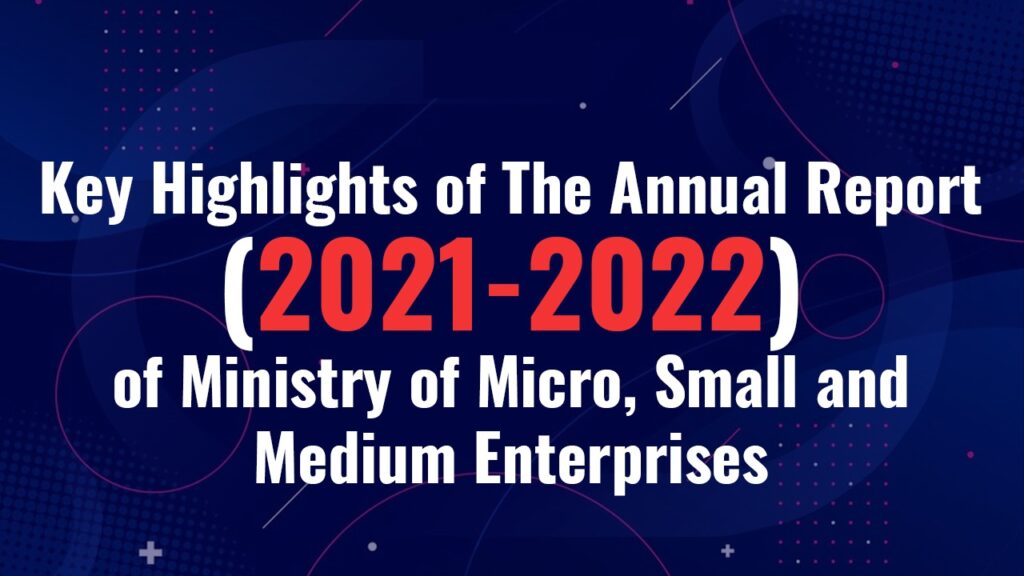We are already aware that small and medium-scale enterprises play a significant role in most economies. Such enterprises account for most of the business across the world. They significantly contribute to the development of the economy and creating jobs.
However, a key constraint to the growth of an SME is access to finance. Keeping this in mind, the annual report is being published by the Ministry of Micro, Small, and Medium Enterprises to let people know more about the operations and working of MSMEs.
Some of the primary functions of the National Board of MSME are:
- Making recommendations for facilitating the promotion, development, and enhanced competitiveness.
- Examine all factors responsible for promoting and developing small, micro, and medium enterprises.
The report released by the ministry for 2021-22 has been released to share data related to the expenditures that they can make on major schemes for nine months, which ended on December 2021.
The budgetary allocation for FY21 was Rs 7,572 crores, whereas, for FY22, it was more than doubled to Rs 15,700 crores. Despite this massive increase in the budget, the expenditure on numerous MSME schemes was decreased.
- The Entrepreneurship and Skill Development Programme aimed at promoting new enterprises built existing MSMEs’ capacity and helped teach entrepreneurial culture across. They allocated the budget of Rs. 10 Crore to it, and it incurred only Rs 1.83 crore out of it.
- A total of 315 programs were launched for the awareness of skill development, entrepreneurship, business management, and much more. Almost 15,599 entrepreneurs were a part of these programs.
- The CLCS-TUS (Credit Linked Capital Subsidy and Technology Upgradation Scheme) allotted Rs 19.43 for the up-gradation of technology and competitiveness of MSMEs, and out of it, only Rs 1.61 crore was used.
- The ASPIRE Scheme works on setting up the business incubators and commercializing business ideas. It allocated Rs 15 crore, of which only 4.31 crore was used.
- Different schemes were introduced for the MSMEs that include MSME-Innovative (Design), MSME-Innovative (Incubation), MSME-Innovative (IPR) schemes. These schemes catered to the product design, development, and awareness of incubation and intellectual property rights ecosystem. The funds allocated to these schemes were Rs 15.21 crores, 23.16 crores, and 25.57 crosses, out of which a small proportion was expended, which amounted to Rs 2.36 crore, 1.52 crore, and Rs 0.14 crore.
- The MSME industry has a fund allocated by the Prime Minister, named the Prime Minister’s Employment Generation Programme. It gave Rs 2,500 crores to generate new employment opportunities, and they spent only 71 percent of it. That said, they spent only Rs 1,785 crore.
- Out of the 15,700 crores allocated for the MSME ministry, only 68 percent was spent, which amounted to Rs 10,761.
- The data was further cited on the number of MSMEs from the National Sample Survey, and there was 6.33 crore incorporated non-agriculture MSMEs in the country. Of these, 1.96 crores were engaged in manufacturing, 2.30 crore in trade, 3,000 in non-captive electricity transmission and generation.
Some Insights on the Recent Developments
As per the data of 10.01.2021, a total number of 65,23,067 enterprises were classified. This figure consisted of 21,13,233 enterprises registered in the manufacturing category. Whereas 44,09,834 enterprises registered in the service sector.
- The ministry notified that the exemption from the requirement of having GSTIN should be only as per the notifications of the Central Goods and Services Act, 2017. It will lead to an increase in registration on the Udyam Registration portal.
- From 21st July 2021, wholesale and retail trades are included as MSMEs. They can register themselves on the UDYAM Portal, and its benefits are restricted to the priority sector lending only.
- With effect from 2nd August 2021, the street vendors are also included as retail trades as MSMEs and can register themselves on the portal.
- Registrations can be done for five major industrial sectors of registration that include textile, apparel, food products, construction of buildings, and construction of activities.
Direct Benefit Transfer in the M/oMSE
The governments of India have introduced several welfare and subsidy schemes, and they have been brought under Direct Benefit Transfer (DBT). This is mainly done to enhance the delivery system by re-engineering all the existing subsidy and welfare schemes.
It would further help the rapid and more straightforward flow of funds and at the same time ensure de-duplication and the reduction of fraud, accurate target of beneficiaries, etc. All the schemes are further categorized depending on the benefit type of the beneficiary, such as cash, kind or composite.
Summary
In the above article, we saw that the Ministry of Micro, Small, and Medium Enterprises released an annual report for 2021 and put forward some significant numbers. The figures depict that the funds allocated for the betterment of the industry were not employed entirely. The MSMEs should plan further about utilizing the funds to a great extent and obtain the maximum benefits.


